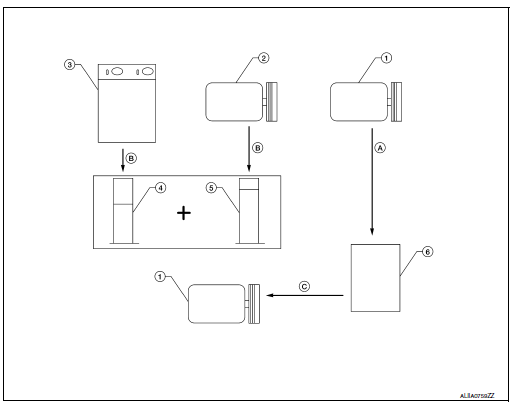Nissan Rogue Service Manual: Oil
Description
MAINTENANCE OF OIL LEVEL
The compressor oil is circulating in the system together with the refrigerant. It is necessary to fill compressor with oil when replacing A/C system parts or when a large amount of refrigerant leak is detected. It is important to always maintain oil level within the specified level or otherwise the following conditions may occur:
- Insufficient oil amount: Stuck compressor
- Excessive oil amount: Insufficient cooling (caused by insufficient heat exchange)
Oil Type: ND-OIL
Inspection
If a compressor is malfunctioning (internal noise, insufficient cooling), check the compressor oil.
1.COMPRESSOR OIL JUDGMENT
- Remove the compressor. Refer to HA-30, "Removal and Installation".
- Sample compressor oil and judge below according to the figure.

Judgement result 1>>Replace compressor only.
Judgement result 2>>Replace compressor and condenser (includes liquid tank).
Perform Oil Return Operation
CAUTION: If a large amount of refrigerant or oil leak is detected, do not perform oil return operation.
- Start the engine and set to the following conditions:
- Engine speed: Idling to 1,200 rpm
- A/C switch: ON
- Fan (blower) speed: Maximum speed set
- Intake door position: Recirculation
- Temperature setting: Full cold
- Perform oil return operation for approximately 10 minutes.
- Stop the engine.
- Oil return operation is complete.
Oil Adjusting Procedure for Components Replacement Except Compressor
Fill with oil for the amount that is calculated according to the following conditions.
Example: Oil amount to be added when replacing evaporator [m (US fl oz, Imp fl oz)] = 75 (2.5, 2.6) + α
|
Conditions |
Oil amount to be added to A/C system
m |
|
| Replace evaporator | 75 (2.5, 2.6) | |
| Replace condenser (includes liquid tank) | 80 (2.7, 2.8) | |
| Refrigerant leak is detected | Large amount leak | 30 (1.0, 1.1) |
| Small amount leak | — | |
| Oil amount that is recycled together with refrigerant during recycle operation | α | |
Oil Adjusting Procedure for Compressor Replacement

- New compressor
- Old compressor
- Recovery/recycling equipment
- Measuring cup X
- Measuring cup Y
- New oil
- Drain oil from the new compressor into clean container
- Record amount of oil recovered
- Install new oil equal to recorded amounts in measuring cups X and Y
- Before connecting recovery/recycling equipment to
vehicle, check recovery/recycling equipment gauges.
No refrigerant pressure should be displayed. If NG, recover refrigerant from equipment lines.
- Connect recovery/recycling equipment to vehicle. Confirm refrigerant purity in supply tank using recovery/ recycling equipment and refrigerant identifier. If NG, refer to HA-4, "Precautions For Refrigerant System Service".
- Confirm refrigerant purity in vehicle A/C system using
recovery/recycling equipment and refrigerant identifier.
If NG, refer to HA-4, "Precautions For Refrigerant System Service".
- Discharge refrigerant into the refrigerant recovery/recycling equipment. Measure oil discharged into the recovery/recycling equipment.
- Drain the oil from the “old” (removed) compressor into a graduated container and recover the amount of oil drained.
- Drain the oil from the “new” compressor into a separate, clean container.
- Measure an amount of new oil installed equal to amount drained from “old” compressor. Add this oil to “new” compressor through the suction port opening.
- Measure an amount of new oil equal to the amount recovered during discharging. Add this oil to “new” compressor through the suction port opening.
 Refrigerant
Refrigerant
Description
CONNECTION OF SERVICE TOOLS AND EQUIPMENT
Shut-off valve
A/C service valve
Recovery/recycling/recharging
equipment
Refrigerant container (HFC-134a)
Weight scale ...
 Performance test
Performance test
Inspection
INSPECTION PROCEDURE
Connect recovery/recycling/recharging equipment (for HFC-134a) or
manifold gauge.
Start the engine, and set to the following condition.
Test co ...
Other materials:
P2100, P2103 throttle control motor relay
DTC Description
DTC DETECTION LOGIC
DTC No.
CONSULT screen terms
(Trouble diagnosis content)
DTC detecting condition
P2100
ETC MOT PWR-B1
(Throttle actuator ″A″ control motor circuit/
open)
ECM detects a voltage of power source for throttle control ...
Changing engine oil
Changing engine oil
Park the vehicle on a level surface and apply
the parking brake.
Start the engine and let it idle until it reaches
operating temperature, then turn it off.
Remove the oil filler cap B by turning it
counterclockwise.
Place a large drain pan u ...
ECU diagnosis information
BCM
Reference Value
NOTE:
The Signal Tech II Tool (J-50190) can be used to perform the following
functions. Refer to the Signal Tech II
User Guide for additional information.
Activate and display TPMS sensor IDs
Display tire pressure reported by the TPMS sensor
Read T ...

 (US fl oz, Imp fl oz)
(US fl oz, Imp fl oz)